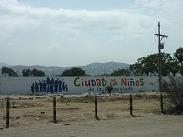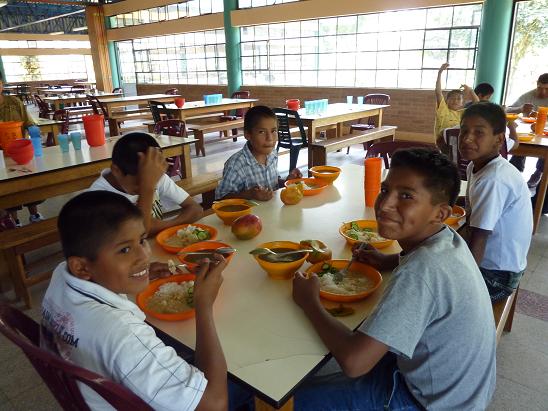
2) The children’s life within La Ciudad de los niños
2000.A. Having a zest for life
The children’s joy of living is the first thing that struck us when we discovered the place.We understood it better after visiting the shantytowns where they are coming from. The misery, the poverty can be escaped by living in La Ciudad.
Everything helps bringing about comfortable feelings, confidence so they are able to grow up in the nicest conditions. Surrounded by persons of willingness ( social worker, religious persons and volunteers), children are given a sense of responsibility; they are blossoming through games and the teaching they are getting.
Children go to school from Monday to Saturday until 2 pm. School (from primary education to high school) is opposite the orphanage and greets other children from the area.
In the afternoon, the younger ones play games or practice sports whereas the older ones learn different jobs and take part in La Ciudad’s life, as we will develop later.
According to what we have been able to see during our days at the orphanage, all activities take place in the utmost discipline and respect. By the way, several children told us their happiness and relief for being at La Ciudad. Everybody seem to be aware of the luck they have to live there.
B. Religious education
The values implanted in those children who do not necessarily acknowledge respect and command in the first place, are mainly taught through religious education at La Ciudad.
A group of 7 Capuchin friars, assisted by several Sisters watch over the education of children.The latter are asked to say the grace before and after their meal, and also to attend Mass every Sunday. This Mass takes place in the orphanage chapel, and children are allowed to go with their families. Brother Hugo Morales makes the most of it: he often uses this Mass as a means to bring together parents and to organize informative meetings.
C. Commitment of all for La Ciudad’s life
Brother Hugo Morales pays a particular attention to it. La Ciudad has been made and must be made by everybody. Parents must not see it as a means to dump their children there.
Thus, to join La Ciudad, parents or relatives have to take the steps to get administrative papers for their children: this is the precondition to to get into La Ciudad. Children also have to go through a medical check-up. Parents are often consulted and sometimes help in the orphanage by working there (cooking for instance).
When relationships are not too uneasy with the family, parents or relatives must come every week-end pay a visit to their children, while the child has to go back home every other week-end and during the holiday. Brother Hogo Morales wishes the child to keep in touch with his/her family. To him, it is crucial to keep links with one’s family, and to remember where one’s comes from. La Ciudad’s mission thus is not to uproot these children from the shantytowns, but to put forward other outcomes, to make possible their insertion into society.
This family tie also depends a lot on the relationship between children and parents. Brother Hugo Morales told us many children who arrived in La Ciudad suffered physical abuse (some were even tortured)before entering the orphanage. In that case, children have no more ties with their families.
In addition to parents, children are the first to be involved in La Ciudad’s daily life. After going to school, everyone works in the interest of the orphanage. Some make bread for the following days, others look after animals, garden, cook...Some take care of the cafeteria, repair pieces of furniture.
Brother Hugo Morales thinks that children must behave as if they were at their home, so they have to get involved in daily chores. That is a way of giving them a sense of responsibilities, but also to teach them a job (baker, builder, clothes maker, garage owner or cook, etc...). Some of them, when they come of age do not leave the orphanage (this is the case of Alexander, whose family we helped) and decide to remain there so as to work or to teach the job they have learnt to younger ones.
Brother Hugo Morales wants children never to forget how lucky they are to be in La Ciudad. Really appreciated by them, he remains very demanding and can also be uncompromising towards a child who does not commit to La Ciudad or who lacks respect. As an example, someone having under 13/20 as an average mark at school has to go back home for a week or two. When the child comes back, he/she is aware of the luck he/she has so he/she starts making efforts. This rule only applies to children who do not suffer real psychological trouble, the latters being cautiously followed-up.
This is how Brother Hugo Morales succeeded in putting La Ciudad de los niños back on its feet, with strictness and principles. He also manages to make these children happy, on a daily basis, giving them the means to get away from their original background.

- 1) Structure et fonctionnement - Structure and functionning - Estructura y functionamiento - Struttura e funzionamento.

- 3) L’aide du Ballon rouge - Help from the Red Balloon - La ayuda del Ballon Rouge - L’aiuto del Ballon Rouge.
 Printable version
Printable version
































































